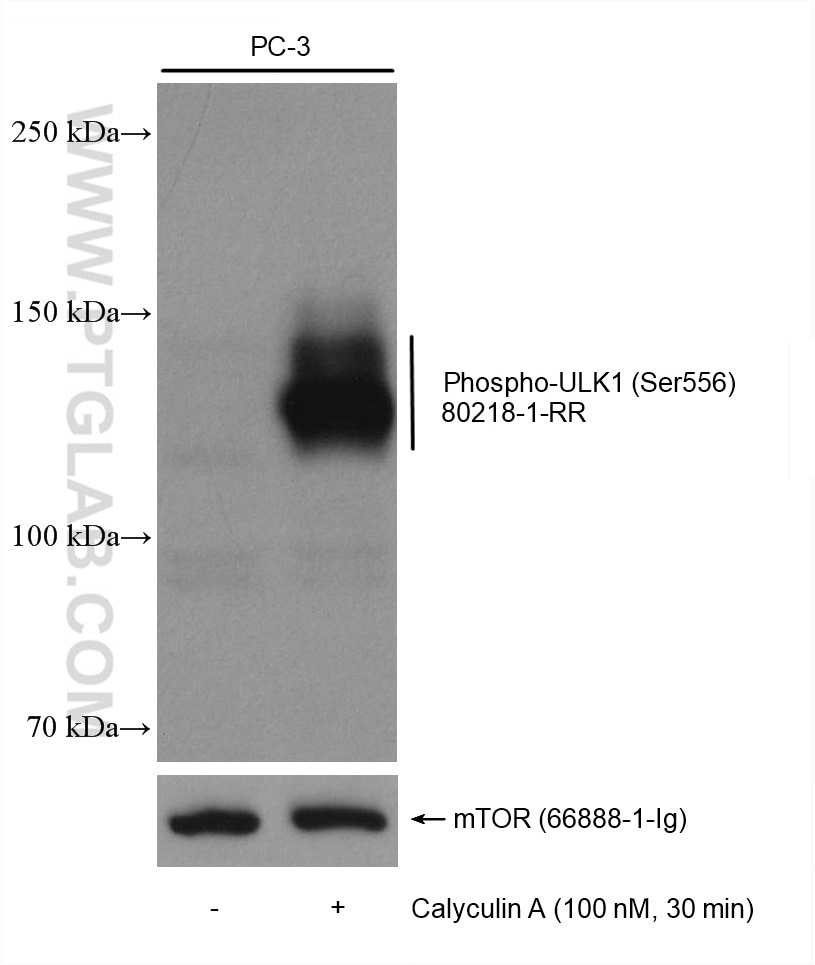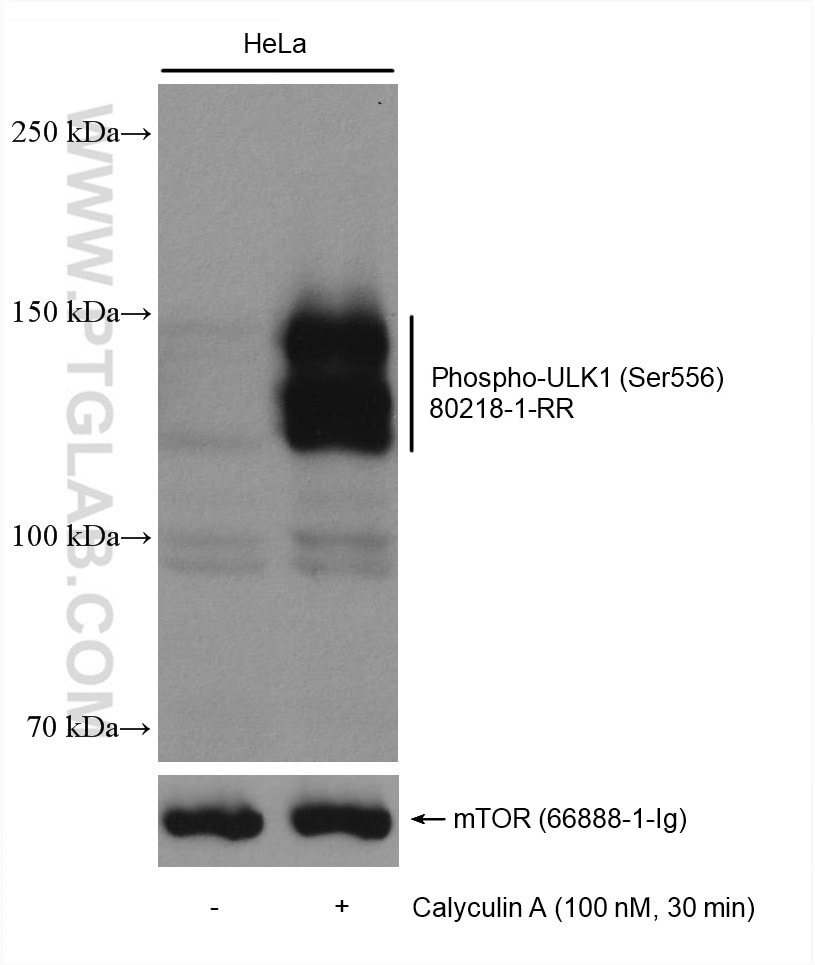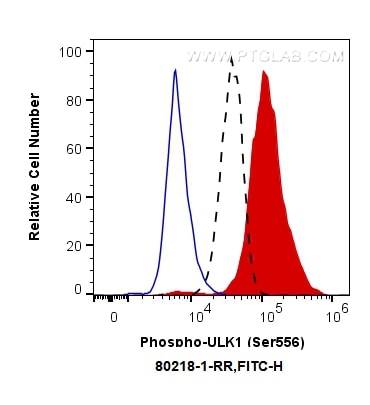Anticorps Recombinant de lapin anti-Phospho-ULK1 (Ser556)
Phospho-ULK1 (Ser556) Recombinant Antibody for WB, ELISA, FC (Intra)
Hôte / Isotype
Lapin / IgG
Réactivité testée
Humain, souris et plus (2)
Applications
WB, IHC, IF, FC (Intra), ELISA
Conjugaison
Non conjugué
CloneNo.
2F5
N° de cat : 80218-1-RR
Synonymes
Galerie de données de validation
Applications testées
| Résultats positifs en WB | cellules PC-3, cellules HeLa, cellules HeLa traitées à la calyculine A, cellules PC-3 traitées à la calyculine A |
| Résultats positifs en FC (Intra) | cellules PC-3 traitées à la calyculine A, |
Dilution recommandée
| Application | Dilution |
|---|---|
| Western Blot (WB) | WB : 1:2000-1:10000 |
| Flow Cytometry (FC) (INTRA) | FC (INTRA) : 0.50 ug per 10^6 cells in a 100 µl suspension |
| It is recommended that this reagent should be titrated in each testing system to obtain optimal results. | |
| Sample-dependent, check data in validation data gallery | |
Applications publiées
| WB | See 21 publications below |
| IHC | See 1 publications below |
| IF | See 1 publications below |
Informations sur le produit
80218-1-RR cible Phospho-ULK1 (Ser556) dans les applications de WB, IHC, IF, FC (Intra), ELISA et montre une réactivité avec des échantillons Humain, souris
| Réactivité | Humain, souris |
| Réactivité citée | rat, Chèvre, Humain, souris |
| Hôte / Isotype | Lapin / IgG |
| Clonalité | Recombinant |
| Type | Anticorps |
| Immunogène | Peptide |
| Nom complet | unc-51-like kinase 1 (C. elegans) |
| Poids moléculaire observé | 140 kDa |
| Numéro d’acquisition GenBank | NM_003565 |
| Symbole du gène | ULK1 |
| Identification du gène (NCBI) | 8408 |
| Conjugaison | Non conjugué |
| Forme | Liquide |
| Méthode de purification | Purification par protéine A |
| Tampon de stockage | PBS with 0.02% sodium azide and 50% glycerol |
| Conditions de stockage | Stocker à -20°C. Stable pendant un an après l'expédition. L'aliquotage n'est pas nécessaire pour le stockage à -20oC Les 20ul contiennent 0,1% de BSA. |
Informations générales
Unc-51-like-kinase 1 (ULK1) is a target of both the mechanistic target of rapamycin (mTOR) and AMP activated protein kinase (AMPK), whose role is to facilitate the initiation of autophagy in response to starvation. ULK1 is phosphorylated on serine 638 and 758 sites by mTOR in nutrient-rich conditions, inhibiting ULK1 activation by disrupting its binding to AMPK. Upon glucose starvation, dissociation of mTOR from ULK1 and phosphorylation by AMPK leads to the activation of ULK1 activity. The S556 site of ULK1 is one of the major AMPK-dependent phosphorylation sites. (PMID: 30517873, PMID: 21258367)
Protocole
| Product Specific Protocols | |
|---|---|
| WB protocol for Phospho-ULK1 (Ser556) antibody 80218-1-RR | Download protocol |
| Standard Protocols | |
|---|---|
| Click here to view our Standard Protocols |
Publications
| Species | Application | Title |
|---|---|---|
J Hazard Mater Graphene oxide disrupted mitochondrial homeostasis through inducing intracellular redox deviation and autophagy-lysosomal network dysfunction in SH-SY5Y cells. | ||
JCI Insight ZNFX1 promotes AMPK-mediated autophagy against Mycobacterium tuberculosis by stabilizing mRNA | ||
Sci Rep EYA3 promotes the tumorigenesis of gastric cancer through activation of the mTORC1 signaling pathway and inhibition of autophagy | ||
Int J Gen Med Sigma-1 Receptor Rescues Autophagy Through AMPK/mTOR Signaling Pathway in Sepsis-Induced Acute Kidney Injury | ||
Bioengineered Shikonin induces apoptosis and autophagy via downregulation of pyrroline-5-carboxylate reductase1 in hepatocellular carcinoma cells. | ||
bioRxiv AMPK is dispensable for physiological podocyte and glomerular functions but prevents glomerular fibrosis in experimental diabetes |




